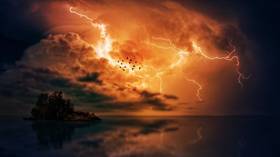The truth is Down Under? Gobsmacked Aussies share conspiracy theories after spectacular green fireball sighting (VIDEOS)
Western Australian skies glowed an ominous green overnight, as a suspected meteorite provided an impromptu celestial pyrotechnics display visible as far as away as Victoria and South Australia.
Many believe the enigmatic explosion of color was related in some way to the asteroid 2002 NN4, as it roughly coincided with the space rock’s flyby of the Earth at about 11:20pm Western Australian time on Sunday. Eyewitness footage shows the spectacular sight (including some NSFW commentary) illuminating the night sky.
“Martians have hit the Pilbara,” wrote one stunned stargazer. “Next phase of 2020 incoming!”
With an estimated diameter of up to 570 meters, asteroid NN4 would likely cause immense damage if it struck the Earth. Mercifully, however, it passed at a distance of 5.2 million kilometres, or roughly 13 times the distance between us and the moon.
“It was really a spectacular observation,” Glen Nagle, a manager at NASA’s Canberra Deep Space Communication Complex, told local media. “People have captured something very special here."
Others speculated the green fireball was rocket debris or space junk reentering the Earth’s atmosphere. However, the lack of crackles, sparks, or other fiery trails, combined with the bright green glow (usually an indicator of the presence of iron) means it was more likely a meteorite than anything else. The jury is still out, however.
“[But] this is quite a clean shot – it was quite a strong line, we didn't see too much fragmentation,” said Renae Sayers, from Curtin University's Space, Science and Technology Centre.
“The reason why this is really interesting, and the jury is out with our scientists, is that earlier this year we shared a paper of a grazing fireball that actually entered our atmosphere, burned 1,300km across the Australian sky and kicked back out into interstellar space, and that's what this looked like as well.”
Given the difficult year that 2020 has been, many online shared some apocalyptic gallows humor, remarking that “July is coming…” with some questioning, “Are these the warning shots before the big one comes?”
While the mystery remains for now, some 60,000 meteorites have been recovered around the world. Despite this, there are currently no plans to sift through Pilbara's red rock landscape for any evidence of a fallen meteorite – for the simple reason that the entire area is composed of material similar to that found in fallen meteorites.
Think your friends would be interested? Share this story!














